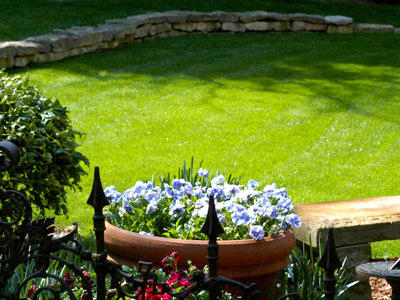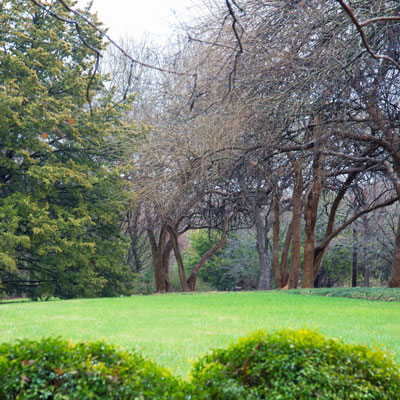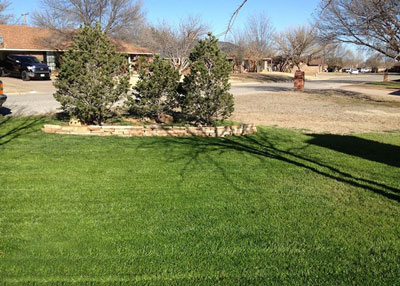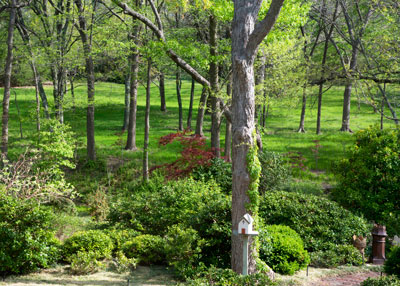Overseeding Warm-Season Turf: September 7, 2017
If you’re in a part of Texas where warm-season grasses turn brown during the winter, and if you want bright green turf from frost right through mid-spring, overseed with ryegrass in the next couple of weeks. It’s not a difficult task, and for those who like it, it’s a grand option. I’ve overseeded my lawn for 30 or 35 years.

Photo: Sperry turf was overseeded with “perennial” ryegrass.
Steps to Success
This isn’t rocket science. Follow these guidelines for great results.
• Mow your lawn at the recommended height. Commercial landscapers will often scalp their bermuda lawns before sowing, but that’s a lot of extra work.
• Sow the rye seed at the rate of 4 to 6 pounds per 1000 square feet. It’s best to sow half of it going east-west and the other half going north-south. Have someone stand along the sides of beds with a large piece of cardboard to prevent seeds from falling where you don’t want them.
• Water it lightly every day or two until it germinates (usually in 10 to 12 days).
• Fertilize the ryegrass after the second mowing, in mid-November and in mid-February with a high-nitrogen lawn food.
• Mow at the recommended height for your permanent lawngrass, whatever that height might be. The ryegrass will adapt.
The ryegrass will die away with the first really warm days of late April and May, at which point your warm-season grass will take over for the summer.

This is annual ryegrass planted on a 1-acre hillside in front of our house. It gives the grandkids a place to play ball in winter.
Perennial vs. Annual Rye
Nurseries sell both annual and perennial rye seed in the fall. In Texas, neither grass will survive the summer – both are annuals here.
Which type, then, is your better choice? In spite of being two to three times as expensive, perennial rye requires probably half the mowings in the spring. Life can become miserable for the person maintaining annual rye when several days of rainy weather prevent its being mowed. It becomes almost unmanageable.
Perennial rye is a finer-textured and far more attractive winter turf. Unless you are seeding a very large area, perennial rye will be a great investment. Not all nurseries, however, have it on hand. Most can order it in for you within a few days.

Photo: Posted on my Facebook page a year or two ago, this is a ryegrass overseeding in Snyder, Texas, where winters can be long and rather cool. Nice work, Troy Lilly!
Warning #1:
The one place that perennial rye probably should not be used would be to overseed St. Augustine in shaded areas. In that setting the rye will be slow to die away in spring and can actually retard the growth of your St. Augustine.
Warning #2:
If you applied pre-emergent weedkiller granules to your lawn in the past couple of weeks they will keep your rye seed from sprouting. You’ll have to wait another year to overseed your lawn.

This view from our sunroom shows ryegrass that was watered the day it was planted in mid-September and not one time thereafter. Fall and winter rains were sufficient in the DFW area that year. Rye can exist on irrigation you would give your warm-season grass to keep its roots healthy and vigorous. In other words, you are not necessarily wasting water when you plant ryegrass.
Does Overseeding Waste Water?
There are those people and cities who contend that overseeding lawns uses water you don’t need to use during the winter. In those years that we’ve been on watering curtailments in our part of Texas, I have still overseeded. I have done so just before my watering day, and I used the watering for both the new seed and for my established lawn.
After that initial watering, I waited until my watering day rolled around again, figuring that if the ryegrass made it, that would be great. If it didn’t, I wouldn’t have lost much.
The worst thing that ever happened was that it was a bit slow to germinate in warm fall weather one year. But by spring, it looked great.
